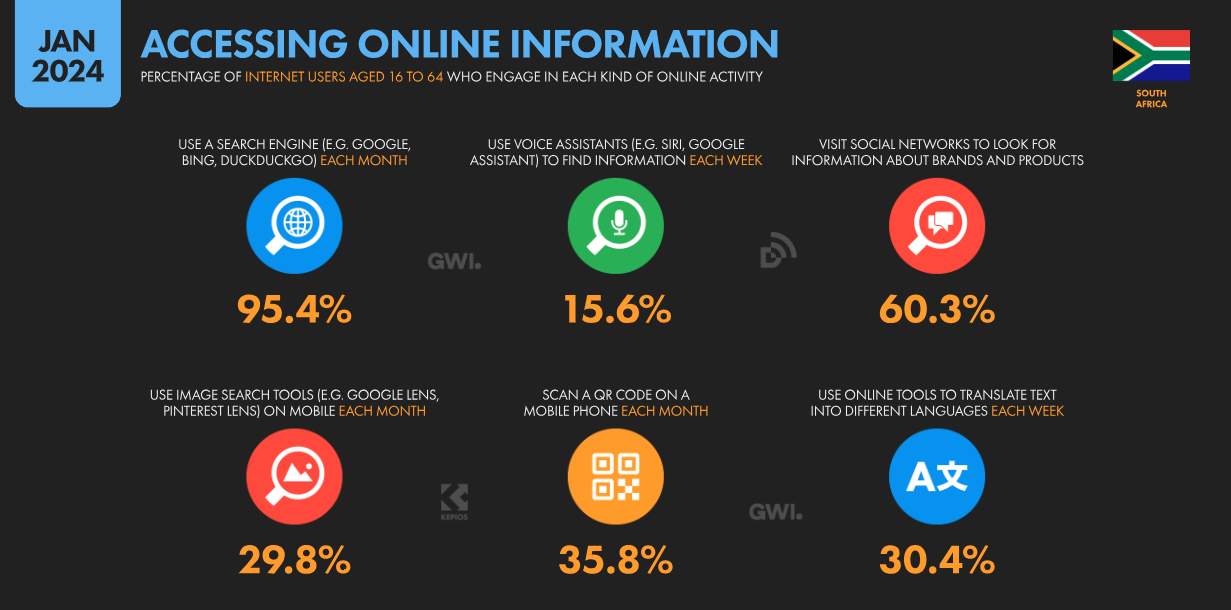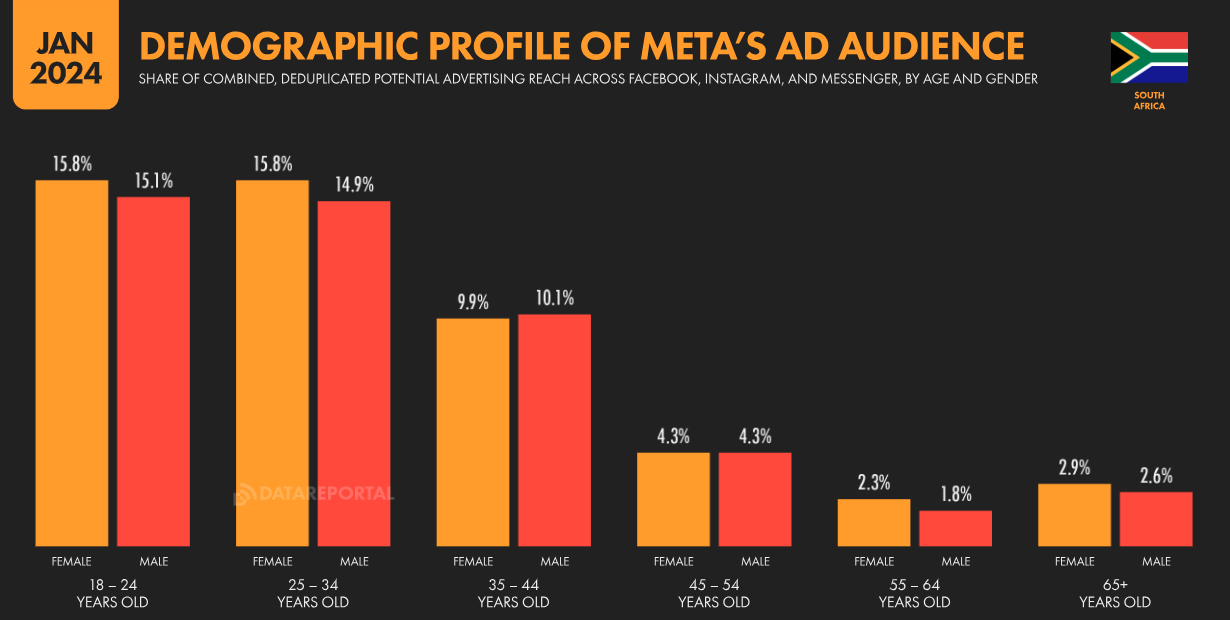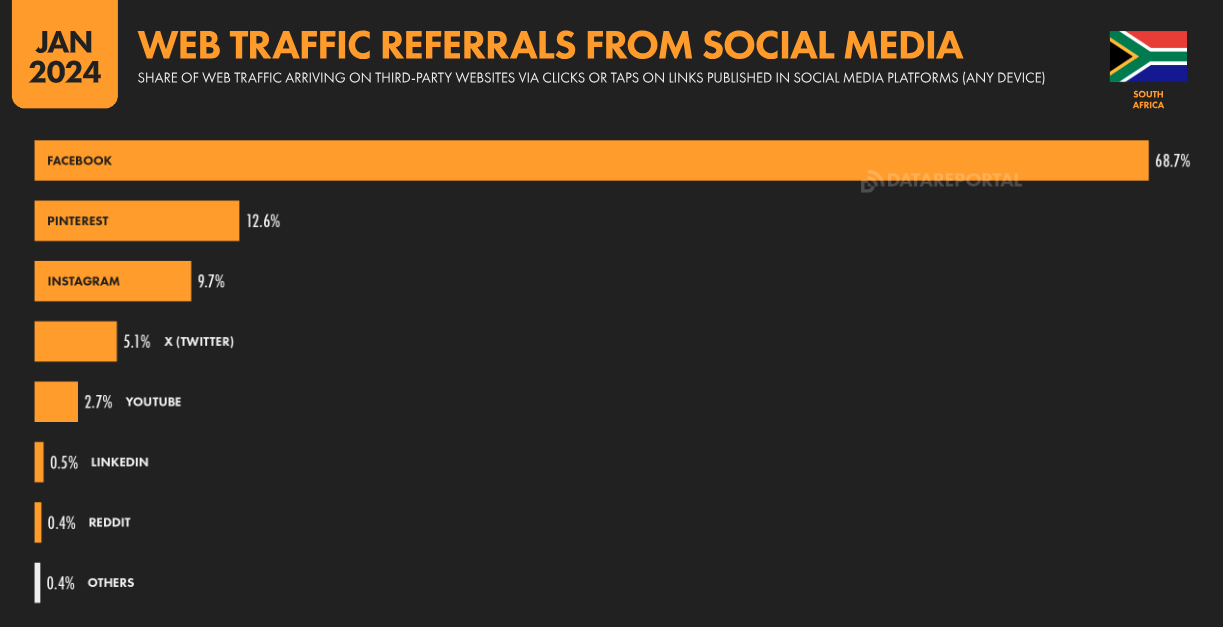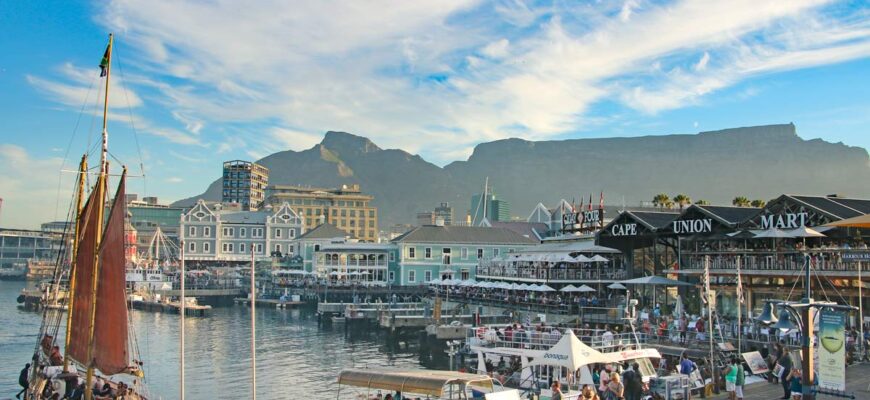South Africa is an amazing country of contrasts that breaks stereotypes and opens new horizons for business. Despite the existing problems, unemployment and inequality, South Africa is the undisputed economic leader of the entire Sub-Saharan African continent. It shows impressive GDP figures, outperforming even some European states.
But the most interesting thing is the huge potential in the field of internet marketing. While many entrepreneurs wrongly underestimate this country, other international businesses are already actively exploring the local market. The numbers speak for themselves – South Africa ranks a respectable 4th in Africa in terms of the percentage of the population actively using the internet in 2023. This makes the country very promising for online business development.
For example, the share of contextual advertising in South Africa last year amounted to an impressive 25% of the total advertising market. At the same time, the total advertising budgets of local companies exceeded 580 million dollars. This opens up huge opportunities for business, especially given the relatively low competition among advertisers in this country compared to most EU countries and the USA.
How many calls and sales will I get by ordering contextual advertising from you? I need to calculate the conversion of my website
Describe Calculate potential ad revenue
Google
the task
in the application
contextual advertising calculator
Features of contextual advertising customization in South Africa
To effectively customize contextual advertising in South Africa, it is imperative to deeply understand the local realities and characteristics of the audience. This is a country with a rich history, a variety of cultures and a unique socio-economic landscape. All these points should be taken into account when creating ads and promoting the brand online.
Target Audience
As of 2024, the Republic of South Africa is home to 59 million people, with an average age of just 27 years old. This young and growing audience is of great interest for starting a business here.
Thanks to the favorable investment climate and the presence of Western companies, high-paying jobs are being created in the country. 65% of the population is employed in the service sector, with the rest working in industry, energy and agriculture.
However, despite economic growth, more than 50% of residents still live below the poverty line, earning less than $250 per month. At the same time, 30% have an income of $1000 or more, and 5% are among the highly paid oligarchs and officials.

South Africa demonstrates an impressive level of Internet penetration and gadget use among the local population. Thus, 68% of residents regularly go online, and mostly with the help of a smartphone. This is confirmed by statistics – 82% of web traffic comes from phones and other portable devices. Therefore, optimizing content for mobile devices is the key to successful promotion.

South Africans spend an average of 10.5 hours online per day. At the same time, 95% of users use search engines to find information about goods and services. This means that contextual advertising in search engines, in particular Google Ads, is a priority channel for website promotion in this country.
Social media also plays an important role in the lives of South Africans – 46% actively use Facebook, Instagram and other online platformsi. Therefore, social media ads can be an effective complement to search engine promotion.

The demographic profile of local social networks shows that the most active users today are young people between the ages of 18 and 34. This age group accounts for more than 30% of users on Facebook, Instagram and other platforms.
Language targeting
The country officially recognizes 11 languages, including English, Afrikaans, Zulu, Sotho and others. That is, in order to reach the entire target audience, advertising campaigns should be set up in several languages. This should also be taken into account when creating a website (in order to reach the right audience, several language versions of the web resource can be provided).
Despite the fact that this is a former British colony and a significant part of the inhabitants speak fluent English, local languages are widespread. Therefore, when creating ads and selecting the semantic core, it is important to take into account the linguistic specifics of a particular region.
For example, different languages and dialects dominate in different parts of the country. For example, English is best for targeting port cities and affluent whites. In other regions, local dialects may be preferred.
Advertising creatives
Unlike the more developed markets of North America and Europe, people here are still receptive to straightforward marketing techniques. For example, clickbait headlines, images of successful people and promises of easy wins can be effective tools for attracting attention.
However, it is important to consider not only marketing but also social aspects when developing creative. This is a country with a complicated history of interracial relations. About 10% of the population is white, and tensions between racial groups are still felt. It is therefore important to avoid stereotypical or potentially offensive images, taking into account the cultural diversity and racial sensitivity of South African society.
When creating texts for advertisements, it is best to prioritize simple and clear wording. Focus on the pains and needs of your customers, emphasizing the specific benefits and advantages of your product or service.
Due to the widespread use of smartphones and other portable devices, all websites and lendings are better adapted to mobile platforms. The visual component of creatives also plays an important role. It is better to make images bright, attractive and reflecting the local authentic flavor.
Geographic targeting
First of all, when setting up Google Ads in South Africa, focus on the largest population centers where the audience is most active:
- Johannesburg. The largest city in the Republic of South Africa with a population of about 5.5 million. It is a financial and industrial center where many national and international companies have their headquarters. The people of Johannesburg are characterized by a high level of education and active use of digital technologies.
- Cape Town. It is located in the southwest and is currently the second largest city with a population of about 4 million people. It is a popular tourist destination known for its picturesque beaches, mountains and rich history. Cape Town attracts many foreign tourists, so advertising in English here can be particularly effective.
- Durban. The third largest city located on the east coast. It is a major port and industrial center with about 3.5 million inhabitants. Durban is also popular with tourists for its beaches, warm climate and unique blend of African, Indian and European cultures.
In addition to the three largest metropolitan areas, other significant cities are worth considering when setting up an advertising campaign. These include Pretoria (the administrative capital), as well as Port Elizabeth and East London. These are important industrial and port cities on the south coast, with a growing middle class and many internet users.
Advertising tools
For promotion in this region, the best effectiveness today is shown by:
- Google Ads search advertising. Since Google dominates the search engine market in South Africa, placing text ads for relevant keywords can attract interested users to the site.
- Google Shopping product ads. They contain a product image, its price and other information, which increases the appeal to potential buyers. In addition, integration with Google Merchant Center allows you to automatically update the availability and price of products, ensuring that your listings are up-to-date.
- Performance Max. This is a new tool from Google, which is a comprehensive solution for promotion across multiple platforms. It combines the capabilities of search, media and video advertising, as well as advertising messages in Gmail and on YouTube.
- Macretplays. In South Africa, the Takealot.com platform plays a leading role. Placing products here opens up access to millions of potential buyers without the need for significant investment or the development of an online store. Marketplace takes care of payment processing, packaging and delivery of goods, as well as ensuring the security of transactions and the possibility of returns.
- Social Media. Facebook, Instagram and Twitter platforms are extremely popular in the country and offer a wide range of opportunities for targeting the demographic, geographic and behavioral characteristics of the local target audience.

What can’t be advertised in South Africa?
- No tobacco. Not only direct advertising of cigarettes and other tobacco products is prohibited, but also sponsorship of various events by tobacco companies, product placement in movies and TV programs, and advertising that indirectly encourages smoking. This state-level ban is intended to protect health and reduce the prevalence of tobacco use.
- Less alcohol. Its advertising aimed at minors and the use of images appealing to young people are prohibited. Advertising of alcoholic beverages must not give the impression that drinking alcohol increases social status, promotes success or improves physical fitness. It is also limited to certain time frames on television and radio.
- You cannot play on people’s gullibility. Particular attention is paid to the protection of vulnerable groups, in particular children and the elderly. Advertising materials should not exploit children’s inexperience, create unrealistic expectations or encourage dangerous behavior. Materials that discriminate against or stigmatize older adults are also unacceptable.
- Honesty is essential. Promises of guaranteed profits or concealment of risks associated with financial products are prohibited. Advertising of conditional lending services must contain clear information about interest rates, terms and conditions of the loan.
- Advertising of prescription drugs directly to consumers is prohibited. Advertising of over-the-counter drugs must remain honest, accurate, and not exaggerate the effectiveness of the product. Claims that the drug can cure incurable diseases or acts as a cheap substitute for professional medical advice are unacceptable.
- Advertising must be clearly labeled. Paid ratings, sponsored content and other forms of marketing must be transparently labeled so that consumers can distinguish them from organic content. Using native ads without proper labeling is considered an unfair practice.
Cost of Google Ads contextual advertising in South Africa
There are many factors to consider when planning a marketing budget, including the level of competition in a particular niche, the cost of a PPC specialist or agency, the number of campaigns created in different languages, the quality of landing pages on the advertiser’s website, and more.
However, the most important factor that determines the overall price of contextual advertising in South Africa is the cost per click (CPC) in Google Ads. To estimate potential costs, you can use Google’s Keyword Planner tool, which provides data on the average cost per click for various queries.
Here are some CPC examples for popular topics:
- airline tickets – $0.60;
- car insurance – $1.20;
- smart phones – $0.45;
- English courses – $0.90;
- solar panels, $1.10;
- food delivery – $0.35;
- hotels in Cape Town – $0.80.
As you can see, the cost per click here is relatively low compared to the developed regions of Europe and North America (Tier 1 countries). This is due to several factors, mainly less competition in this market and a less solvent audience.
Google’s share of total search traffic in South Africa

Google unequivocally dominates the market, attracting an impressive 93.4% of all search traffic in the country as of September 2024. This figure indicates the highest level of trust South African users have in the system. In other words, setting up Google ads in South Africa is usually the most effective way of promotion.
The closest competitor here is Microsoft’s Bing, which accounts for 5.74% of traffic. Although its figure is significantly lower, it still demonstrates that a certain proportion of South African users prefer alternative search engines.
Yahoo, once one of the leaders in the global search market, now receives a modest 0.35% of traffic from South Africa. This reflects the global trend of declining popularity of Yahoo against the backdrop of strengthening positions of Google and Bing.
The presence of other systems in the South African market is minimal. Petal Search, for example, accounts for only 0.3% and DuckDuckGo, which positions itself as a private and secure alternative to Google, receives only 0.12% of users.


